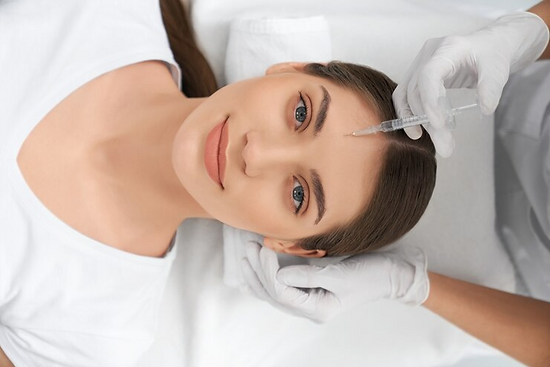Neurotoxins (Botox)

BOTOX®
BOTOX® Cosmetic is a prescribed medication administered via injections into muscles to temporarily enhance the appearance of moderate to severe forehead lines, crow’s feet lines, and frown lines between the eyebrows in adult individuals.
Types of Botox
Forehead
Crows-Feet
Frown Lines
Lip Flip
Neurotoxins
What are Neurotoxins?
Neurotoxins, which include Botox, Dysport, and Xeomin, are a class of injectable solutions designed to selectively inhibit nerve receptors within the muscle tissue. This temporary interruption of nerve signaling effectively impedes the formation of undesirable lines and wrinkles, resulting in a more youthful appearance. Moreover, these versatile neurotoxins have proven efficacy beyond cosmetic applications,demonstrating their utility in the management of diverse conditions such as muscle stiffness, muscle spasms, excessive sweating, and overactive bladder. Their therapeutic potential extends beyond mere aesthetic enhancements, providing individuals with a range of options for addressing various medical concerns.
Who Can Benefit From Botulinum Toxin?
Neurotoxins cosmetic injections constitute a valuable intervention in addressing the visible manifestations of the aging process.This minimally invasive treatment method effectively mitigates the appearance of fine lines and wrinkles across multiple facial regions such as the eyebrows, forehead, nose, eyes (crow’s feet), lips, chin, jawline, and neck. By effectively addressing these facial concerns, they offer patients the opportunity to achieve a more refreshed and rejuvenated aesthetic appearance.
How Often Do I Need To Be Injected?
The frequency at which Neurotoxin treatments are recommended depends on individual factors and desired outcomes. Typically, the effects of Neurotoxins are noticeable for an average duration of approximately three to four months. Consequently, it is advisable to consider retreatment at this juncture to maintain optimal results. Overtime, as the muscles become acclimated to the treatment, a phenomenon characterized by reduced contraction may occur.This adaptation affords the potential to space out treatments at extended intervals.To align with your distinct requirements, it is best to consult with your healthcare provider who can determine the appropriate frequency of treatments based on an assessment of your unique circumstances.
Contraindications:
There are certain conditions and circumstances in which botulinum toxin injections are not recommended.While botulinum toxin injections are generally considered safe,it is important to avoid this treatment if you are pregnant, breastfeeding, or if you have specific medical conditions.
Neuromuscular Diseases:
Botulinum toxin should not be administered to individuals with existing neuromuscular conditions, as it may exacerbate the symptoms and potentially lead to undesirable complications.
In cases where a person already has drooping eyelids, the use of botulinum toxin injections may further accentuate this condition, leading to an unsatisfactory outcome.
Weak Facial Muscles:
If an individual has weak facial muscles, botulinum toxin injections might not achieve the desired results or may result in an uneven or unnatural appearance. These contraindications serve as important considerations for the safe administration and optimal outcomes of Neurotoxin injections. It is crucial to consult with a healthcare professional who will carefully evaluate your medical history and individual circumstances to determine whether Neurotoxins area suitable treatment option for you.
Side Effects:
When it comes to the administration of botulinum toxin injections, potential side effects can occur and may vary depending on the specific treatment area.The majority of these side effects are typically mild in nature and tend to improve within a short timeframe of approximately one to two days. Possible side effects associated with Neurotoxins injections encompass:
- Pain, swelling, redness, or bruising at the site of treatment
- Flu-like symptoms
- Headache
- Neckpain
- Upset stomach (indigestion)
Temporary drooping of the eyelids (ptosis). Eye irritation or redness. While these side effects can arise, it is essential to note that they are generally transient in nature and resolve with time. It is recommended to discuss any concerns or potential side effects with your healthcare provider to ensure a comprehensive understanding and appropriate management.
